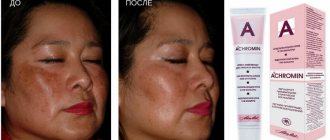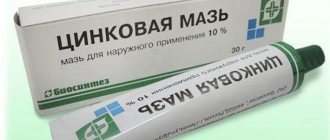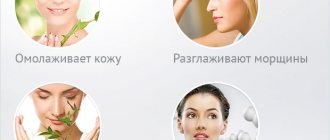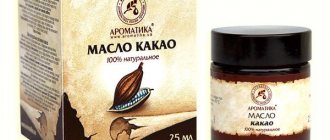Heparin ointment is a direct anticoagulant. It is intended for external use. The drug is a white or slightly yellowish homogeneous mass. Heparin ointment is made on the basis of petroleum jelly, which ensures ease of application. The stability of the composition is maintained by glycerin.
The combined drug contains three main components:
- Heparin sodium. This substance is an anticoagulant. It promotes the resorption of hematomas, relieves swelling and reduces inflammatory processes.
- Benzocaine, which provides the drug with analgesic properties.
- Benzyl nicotinate. This substance accelerates the penetration of heparin through the skin.
The long shelf life of the drug and the preservation of medicinal properties are ensured by the presence of a preservative in the composition - nipagin. The anti-inflammatory effect of the ointment is enhanced by another additional component - peach oil.
The ointment is packaged in compact aluminum tubes of 10, 20, 25, 30 or 50 g. This allows you to select the amount of product according to the situation. The tube is packaged in a cardboard box along with instructions for use of the medicinal product.
Composition of heparin ointment, its effect on the skin
The composition of this product may vary slightly depending on the specific manufacturer.
Heparin ointment in facial cosmetology, reviews of which are positive, is used to solve a number of aesthetic problems.
The main components used are the following:
- Heparin. This component is responsible for reducing blood clotting, which in turn prevents the formation of blood clots.
- Benzocaine. This is an excellent analgesic that relieves pain.
- Benzyl nicotinate. This is a vasodilator that ensures the maximum rate of absorption of the drug. This effectiveness explains the positive reviews on the use of heparin ointment in facial cosmetology.
Heparin ointment is a complex drug that thins the blood, improves skin condition and has a pronounced anti-aging and anti-inflammatory effect.
Of the auxiliary components in heparin ointment, it is worth noting the following:
- Petrolatum. It is used to soften, which in turn allows the skin to remain moisturized, protecting against peeling and drying.
- Stearic acid improves the natural properties of the skin, which is protected from ultraviolet radiation, cold and wind.
- Glycerin is necessary for high-quality moisturizing and smoothing of the skin.
- Peach oil contains a variety of vitamins, so it perfectly nourishes the skin, improving its condition and improving intracellular processes.
Be careful! This product contains numerous components that can lead to allergic reactions. Therefore, before applying the ointment, you should do a test for unwanted effects.
Features of the use of heparin ointment in facial cosmetology
Due to its properties, this ointment is widely used for cosmetic purposes. Heparin is used to solve problems of swelling under the eyes and bruises, rosacea, acne and other skin inflammations.
Read the popular article on the site: Menopause in women: symptoms, age-related characteristics, treatment with effective methods.
When using the product in question for cosmetic purposes, you should remember that it has contraindications. This is especially true for sensitive skin, which may experience unpleasant consequences: itching, burning, redness.
This cream is also used to rejuvenate the skin . The properties of heparin to smooth out wrinkles, restoring the former youth of facial skin, are known. Such rejuvenation courses are carried out using heparin ointment on an ongoing basis, which eliminates existing age-related changes.
In cosmetology, heparin can be used both in single applications and in courses lasting several months . It depends on the condition of the skin and the desired result.
If we talk about the advantages and disadvantages of heparin, it is worth noting the following:
| Advantages | Flaws |
| Efficiency | Possibility of allergic reactions |
| Affordable price | Use with caution on sensitive skin |
| The versatility of the cream is confirmed by numerous reviews of the use of heparin ointment for the face in cosmetology |
Side effects
If the product is used incorrectly, negative reactions may occur in the body.
They appear as:
- burning or itching occurs immediately after application;
- skin hyperemia;
- ruptures of subcutaneous capillaries, which are manifested by the formation of bruises;
- dryness and flaking of the skin;
- allergic rashes;
- comedones (formed due to exceeding the recommended dosage);
- the appearance of vascular mesh;
- swelling of treated surfaces.
If adverse effects occur, use of the ointment should be discontinued. If side effects persist, you should seek medical help.
Instructions for using heparin ointment for facial skin rejuvenation
Heparin ointment in facial cosmetology, reviews characterize this product as effective and efficient in solving the problems of premature skin aging, and with regular use it can improve the tone and texture of the face.
this ointment for rejuvenation twice a day to problem areas in a thin layer . Often, a week-long course is sufficient, after which a short break is taken and a week-long course is repeated.
Active components perfectly help solve the problem of strawberry complexion, wrinkles, enlarged pores and excessive pigmentation, which is typical for age-related skin changes.
How to use heparin ointment for expression lines
The complex effect of the heparin contained in this product and a number of other auxiliary components allows you to cope with facial wrinkles. The active components from this cosmetic product penetrate the epidermis, improve nutrition and actively moisturize it.
Don't miss useful advice from doctors about: Sinusitis: symptoms and treatment at home
Cell restoration is accelerated, which in turn allows you to restore the structure of the skin, which again acquires a young and healthy appearance.
When used against facial wrinkles, it is necessary to apply a thin layer of the cosmetic product onto the skin of the face. At the same time, avoid getting the drug on the mucous membranes. The effectiveness is shown by alternating heparin with cosmetics based on natural nourishing oils.
The active components of heparin ointment in cosmetology perfectly help solve the problem of strawberry complexion, wrinkles, enlarged pores and excessive pigmentation, which is typical for age-related skin changes. This is evidenced by numerous reviews.
It is important to know! The product in question shows its maximum effectiveness when used simultaneously with a variety of vitamin complexes. It is this complex use that explains the positive reviews of heparin ointment in facial cosmetology.
Reviews based on the results of use
Ekaterina (age 36 years)
I decided to determine an anti-aging complex that was suitable for me, that is, effective means to solve several problems. Here there is dullness of the skin and dryness, as well as wrinkles. Some wrinkles are already quite deep, and in some places they have appeared recently. I decided to quickly eliminate the first ones in a more radical way, and for the more recent ones I bought heparin ointment, having read about hyaluronidase. The effect did appear, so I recommend it.
Svetlana (age 28 years):
To be honest, I used the ointment for a completely different purpose - to eliminate rosacea. As a result, I saw a positive effect on nasolabial wrinkles, which, unfortunately, began to appear recently. At first I thought that I had convinced myself of this, but my friend also noticed my “refreshed appearance.” At the same time, heparin ointment for wrinkles is available in almost all pharmacies and is quite inexpensive.
Reviews from cosmetologists:
Cosmetologist Sharapova Yu.G.:
At the moment, in the field of skin care cosmetology, as well as plastic surgery, many products have been developed to combat aging facial skin. They are often expensive and still worth the price. After all, this is the price of beauty. However, in the first stages of age-related changes, it is worth paying attention to an integrated approach to facial skin care. It, of course, should imply a constant selection of suitable means for a comprehensive effect, as well as additional procedures in the form of serums, masks, etc. Heparin ointment can be one of such remedies if you correctly determine the skin type and the existing problem, as well as if you follow the instructions for use, it will somewhat improve the regenerative abilities of the skin, and will also have a positive effect on its chemical composition.
Instructions for using heparin ointment for acne
One of the properties of this ointment is to reduce inflammation , which allows it to be used to solve acne problems. The active components in this ointment regulate blood flow, improving cell turnover, and relieve the skin of inflammatory processes that lead to acne.
To combat acne, the medicinal composition must be applied only to existing problem areas of the skin. At the same time, 2-3 applications are performed per day, which allows a week after the start of treatment to almost completely get rid of acne, while the skin color noticeably improves, inflammation and swelling are eliminated.
How to use heparin ointment for puffy eyes
Heparin ointment is widely used in cosmetology against swelling under the eyes. It should be said that the skin around the eyes is highly sensitive, so the cream should be used with the utmost care.
When performing such cosmetic procedures, a small amount of ointment should be used , and if any allergic reactions or inflammation occur, you should stop using this product.
Heparin ointment must be applied with the tip of your finger, distributing the cosmetic product in the thinnest layer . It is recommended to carry out this procedure no more than once a day. Five to seven days after starting to use this product, the first results will be noticeable.
Read the popular article on the site: Dry cough in an adult - treatment with drugs and folk remedies.
Be careful! When using ointment to solve the problem of swelling under the eyes, you should not allow the ointment to get into the eyes, otherwise this can lead to conjunctivitis and inflammation of the mucous membrane.
Interaction
The anticoagulant effect of heparin is enhanced by the simultaneous use of the drug with antiplatelet agents , anticoagulants and NSAIDs.
The use of the drug with thyrotoxin , ergot alkaloids , antihistamines , tetracycline and nicotine reduce the effect of heparin .
Heparin should not be administered topically in combination with NSAIDs, H1-histamine receptor blockers, or tetracyclines.
Contraindications and possible consequences of using heparin ointment in cosmetology
Like any other cosmetic or therapeutic product, heparin ointment has contraindications for use. For example, such a remedy should not be used near open wounds with purulent processes .
also not recommended to use it if there is reduced blood clotting or low platelet levels. In rare cases, individual intolerance may occur, which is expressed in the appearance of an allergic reaction, redness and inflammation.
Side effects of using this cosmetic product include itching, dermatitis or urticaria. If such side effects occur, you should immediately stop using this product.
Five to seven days after starting to use this remedy against puffiness under the eyes, the first results will be noticeable.
Heparin ointment is an inexpensive and effective cosmetic product that has a complex effect , solves problems with age-related changes in the skin, relieves acne, inflammation, redness, and facial wrinkles.
Read the popular site article: Clotrimazole ointment, suppositories - instructions for use for women
At the same time, you should use this product with caution, as it can lead to severe allergic reactions on the skin.
Reasons for the appearance and areas of localization of post-acne
The skin is the largest organ in the human body, and it has a complex structure. In addition to the epithelial cells that form the continuous skin, there are also hair follicles, sweat and sebaceous glands. It is the glands that secrete sebum and form a protective hydrolipidic mantle on the surface of the epithelium that suffer during the development of acne.
To begin with, it is important to understand why acne occurs. When the sebaceous glands malfunction, the epithelium in the area of the ducts thickens, the lumen of the gland narrows and sebum cannot be regularly and fully released through the pores to the surface. Then the fatty secretion is retained inside the gland duct itself, which provokes inflammation with the participation of microbes that are constantly present on the surface of the skin, making up its microflora.
The process of acne formation goes through certain stages:
Initially, comedones are formed - an increase in the size of the sebaceous gland. Nodules form in the skin with an irritated opening of the sebaceous gland. As the process develops, black dots form in the center, and disturbances in the outflow of sebum, microbial activity, and the work of leukocytes during inflammation lead to the formation of purulent heads (pustules).
By themselves, these elements can leave behind scars and uneven skin, and if they are further injured, if you squeeze out blackheads or purulent heads, the inflammation only intensifies, and the purulent contents can spread to neighboring areas of the skin.
To prevent inflammation from spreading, to prevent damage to more and more areas of tissue, and to prevent pus from penetrating into neighboring areas, inflammatory changes form around the damage to the sebaceous gland.
Swelling occurs in the area of the pimple, collagen production is stimulated, scar changes are formed: connective tissue elements are formed, new capillaries grow, which gives redness, the work of pigment cells is stimulated - pigment spots are formed - persistent and with uneven edges.
Especially often, problems arise on the face, mainly in the forehead, on the nose and cheeks, on the chest, they also appear in the décolleté or on the back.
Redness disappears over time, pigmentation becomes less bright, scars can atrophy, forming dimples, or, conversely, become convex and rough.











